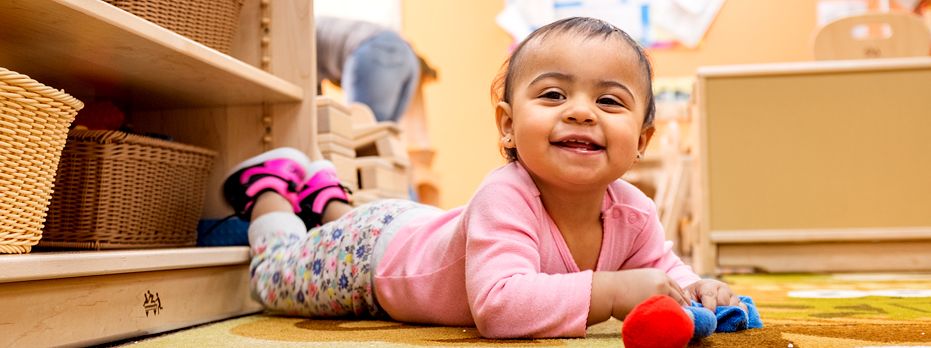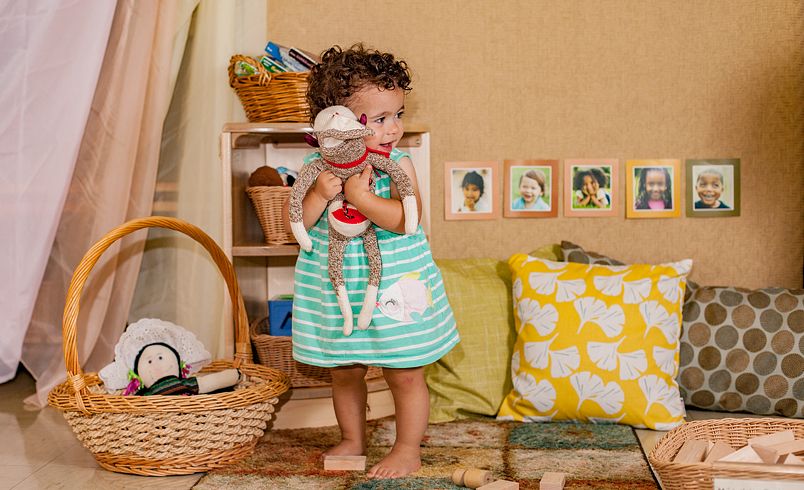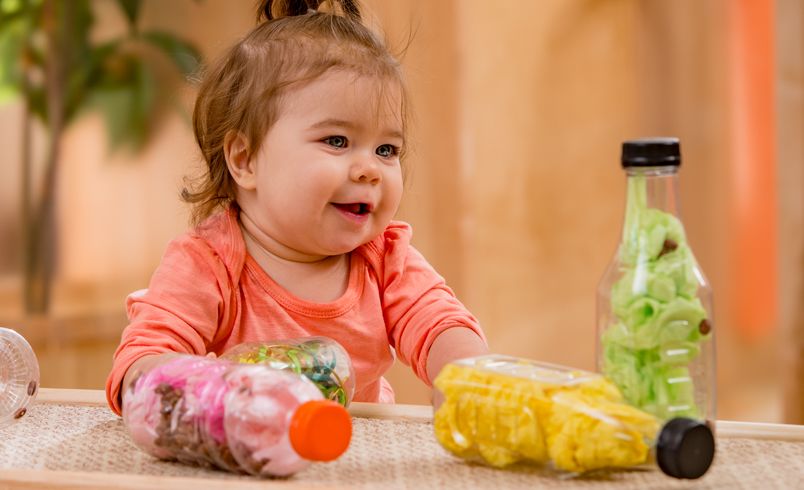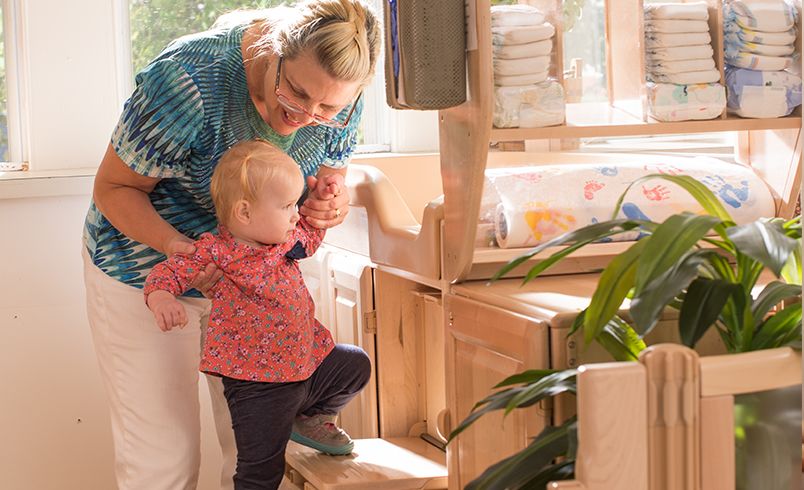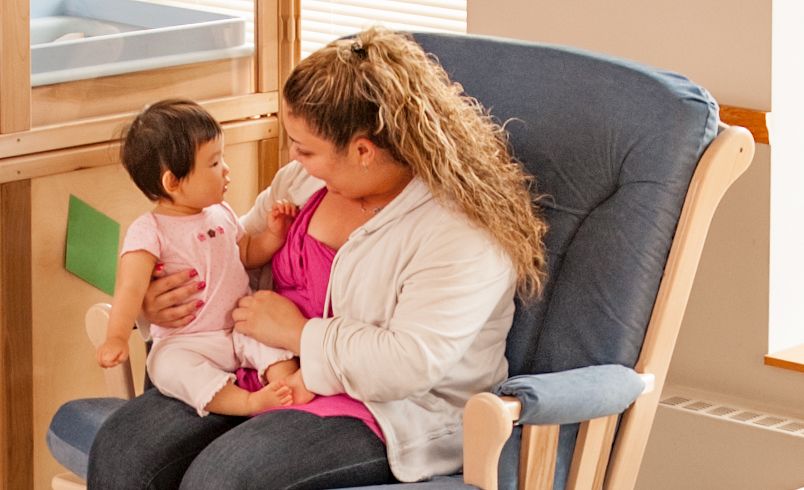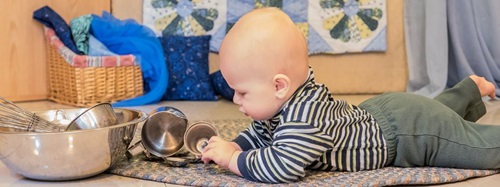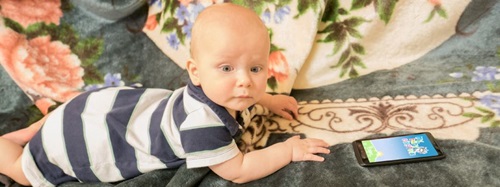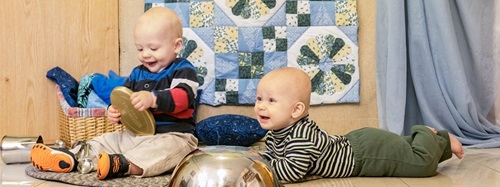Rethinking Infant Curriculum Part 1:
Creating "Contexts" for Learning
| January 2021In many ways, infants are small scientists (Gopnik, Meltzoff, & Kuhl, 1999). They actively gather information about what objects and people are like. They actively investigate and experiment with how one relates to another. Just like scientists, infants move beyond what they know, to discover what they do not know. Infants are on a journey of discovery, actively making meaning of all they encounter.
Infants ask us to join them as traveling companions on this meaning-making journey (Rinaldi, 2006). Our role in this is quite specific: providing a safe, engaging play space, graciously inviting them as collaborators in the daily routines, and generously sharing the language and expectations of this new world they inhabit.
Many anxious policy makers (and publishers who have answered their call) argue that the best way to support infant-toddler learning is to require teachers to follow a commercial curriculum. However, those who work closely with infants and toddlers and witness their innate capacity to learn suggest otherwise. Teaching and learning with infants and toddlers is most successful when the emphasis is on providing teachers the time and resources they need to create contexts for infants that invite learning to take place (Lally, 2009).
So what does this mean? First, consider the fact that infants and toddlers learn throughout the day, in three contexts: 1) Play space—places provisioned with materials that invite investigation and experimentation; 2) Care routines—routine experiences that are designed as invitations to infants to actively participate in the care activity; and 3) Conversations and interactions—interactions between children or adults and children that offer useful information. To offer meaningful “curriculum” to children birth to 3, we need to thoughtfully plan each context.
Play Space as Context for Learning
Just as scientists require well-stocked labs, infants require well-provisioned play spaces. This means a space that allows them to freely move in increasingly more complex ways, and that is provisioned with engaging materials. To create such a space, we pay close attention to what infants are doing with their bodies and with their attention, both of which transform as infants develop.
Very young infants initially peer at and then bat at nearby objects in an attempt to grasp them. Safe, non-toxic objects that are easily grasped, placed within arm’s reach, offer an engaging play space. Objects easily grasped include those with a firm edge that provides a handhold, for example the curved lip of a small metal bowl, the thin edge of a metal canning jar ring, or the rigid edge of a small, sturdy box. Objects that have indentations, protrusions, or appendages also facilitate the grasp, for example, a stuffed toy giraffe with a long neck, an ice cube tray, or a stiff cotton napkin propped in a peak (Gerber, 1998). Objects that have a bit of height and are resilient to the touch enhance the likelihood of a successful grasp, especially for infants not yet rolling or crawling. Since very young babies have limited arm control, objects in the play area should be lightweight.
Once infants begin to crawl and pull to stand and walk, they go in search of objects of interest. Preparing the play space for mobile infants requires attention to what materials are offered as well as the ease with which infants find them. Low, wide baskets, each with a distinct type of toy, facilitate their search. For example, crawlers might discover in one basket a collection of metal, wood, and plastic jar lids and in another, a collection of nesting cardboard gift boxes. As they examine with eyes, fingers, and mouth the curve of a metal jar lid or the angled corner of a box, they capture these physical properties and hold them in memory, a memory of sensations and feelings. This play supports them in building concepts like classification and number: “This is just like that.” Safe, non-toxic, ordinary objects and repurposed and recycled objects, commonly available, make the best infant toys and assure a richly-provisioned play space.
Ordinary objects are simple things, like pots, boxes, bowls, cups, tubes, utensils, or swatches of fabric, most often available at no cost. Most are open-ended, with features that invite infants to use them in a wide variety of ways. In the mind of an infant, a colander, an object ordinarily found in the kitchen, becomes a hat or an object to see through. Infants also enjoy investigating collections of ordinary objects from the natural world, including leaves, bark, pinecones, rocks, and sturdy shells, all of which should be selected with safety in mind.
As infants learn to crawl, sit, stand, and walk, we support balance and mobility by offering a firm surface that provides easy traction for pushing up with hands, arms, torso, knees, and feet. Infants challenge themselves to rise into increasingly more upright postures, first sitting up and in short time, pulling to standing. We support this by offering stable, low cushions, platforms, benches, tables, cardboard boxes, rungs secured to a wall or part of a wooden climber. Infants who master pulling to standing enjoy lingering in this new posture. Any raised surface they pull to becomes a potential place to explore. When a variety of engaging toys are placed on top of a sturdy overturned box or bench, crawlers delight in the challenge of pulling themselves up and standing with balance to explore what they find there. Low, wide raised surfaces and slightly-inclined slopes and stairs attract the accomplished crawler or walker, as they work on what it takes to crawl, walk, or climb with balance.
In preparing the play space as a context for learning, teachers set the stage for learning but do not direct the learning. They provision the play space and allow infants to actively initiate the play.
Care Routines as Context for Learning
Care routines provide a second context for learning. Meals, diapering, toileting, dressing, and hand washing are caregiving rituals that punctuate the day, but when we design them as collaborative routines that invite infants’ active participation (Gerber, 2002), they become rich learning opportunities. Infants enjoy pitching in as active participants in the care, ready to use their emerging skills and ideas (Rogoff, 2011). To design care routines as contexts for learning, we plan the set-up of space and materials, but we also plan what we say and do as invitation.
For example, very young infants, who hear, “And now I am going to lift you up,” and simultaneously see outstretched hands, might show an expression of interest or adjust body position in anticipation. Older infant might be invited to choose which arm to put first into the sleeves of a shirt; to hold a wet wiping cloth, in anticipation of removing the diaper; or be offered an opportunity to climb low stairs to reach a raised changing table. Each is an opportunity for the teacher to watch and notice how the child responds, revealing how the child might be connecting one idea to another, one object to another, or one action to another, building desired concepts and skills.
Mealtimes offer rich opportunities to invite infant participation. For example, we can offer young infants a chance to see the bottle, in anticipation of opening the mouth. We can invite older infants to find on a low shelf the sturdy bowls, cups, or placemats used for the meal and carry them to the meal table. By providing a small, clear pitcher, we can invite them to pour a beverage into an open-top drinking glass. Other invitations might include an opportunity for children to help clear items from the table and put them in a designated container after the meal, or to daily check a simple helper chart.
Older infants enjoy pitching in on daily tasks, for example—joining with a friend to carry a basket of toys to an outdoor play space; digging apple peals into a low compost bin to generate nutrient-rich soil to return to the garden, or returning clothes or meal containers to a carry bag in preparation for going home.
Conversations and Interactions as Context for Learning
Everyday conversations and interactions provide a third context for learning. When a curious infant bites the arm of a nearby infant, teachers intervene with words and actions carefully chosen to help infants learn what is acceptable and what is not. An infant who has just bit another might hear, “When you bite him, that hurts him. You may not bite people. If you feel like biting, bite this plastic toy.” With this thoughtful intervention, teachers support infants in understanding the cause and effect of their actions and in learning categories with respect to behavior—some actions are ok, while others are not.
Infants build the concept of representation in pretend play, but they also build vocabulary, so simply narrating the play at hand supports infant learning. For example, upon seeing an older infant pat a closely-held cloth toy, a teacher might say, “Ah, you are putting your baby to sleep.” If invited to join in the play with a smile, a look, or a gesture, a teacher might do so, but in an unobtrusive way, for example, softly singing a familiar naptime song in rhythm with the toddler’s actions.
How we respond to keep infants safe when taking on a challenging move also requires thoughtful planning. A newly-walking infant who approaches an inclined slope might hear the teacher say, “This is a high slope. It might take some time for you to figure out how to walk down. I know you crawl down easily, but walking is different. I’ll stay near you to make sure you’re safe.”
In each context—play spaces, care routines, and everyday conversations and interactions—infants learn. They build desired concepts and skills that provide a foundation for lifelong learning, they delight in their discoveries, and they enjoy the collaborative process of interacting and communicating with others.
This article is adapted from Teaching and learning with infants and toddlers: Where meaning-making begins, 2nd edition, published in 2020 by Teachers College Press.

